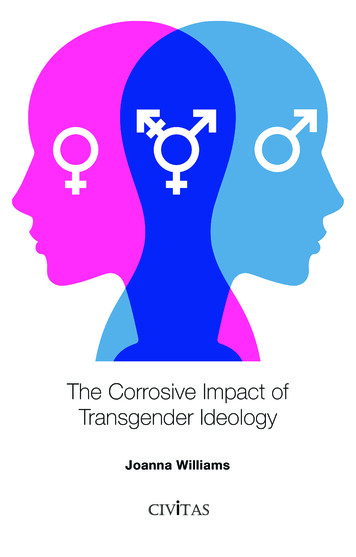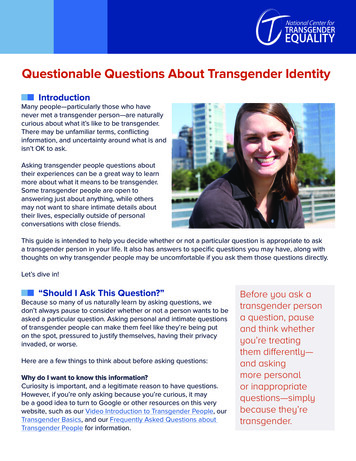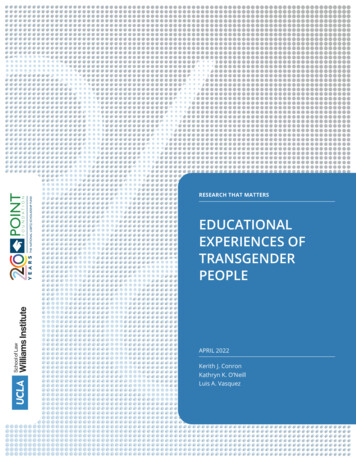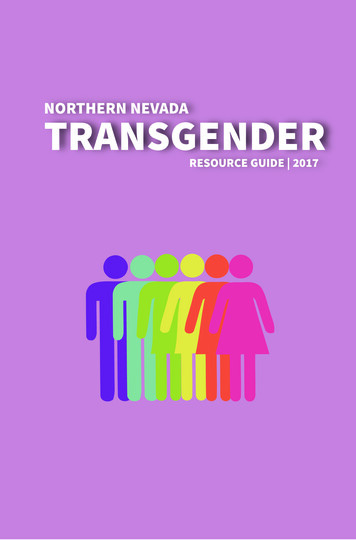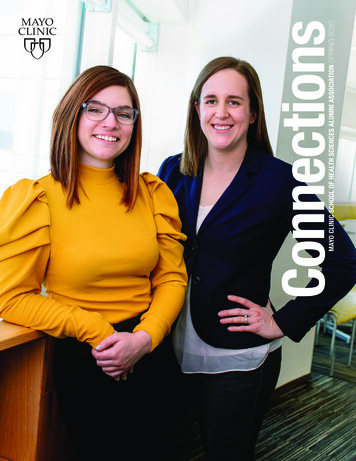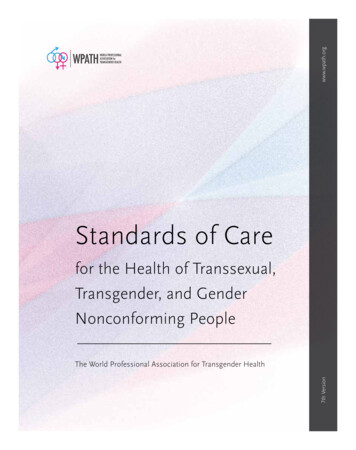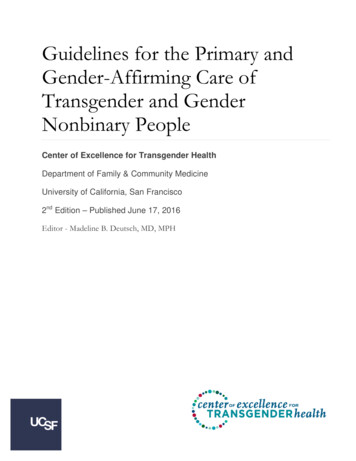
Transcription
Guidelines for the Primary andGender-Affirming Care ofTransgender and GenderNonbinary PeopleCenter of Excellence for Transgender HealthDepartment of Family & Community MedicineUniversity of California, San Francisco2nd Edition – Published June 17, 2016Editor - Madeline B. Deutsch, MD, MPH
Guidelines for the Primary and Gender-Affirming Care of Transgender and Gender Nonbinary PeopleIntroduction to the guidelinesThe Center of Excellence for Transgender Health (CoE) at the University of California – SanFrancisco is proud to present these Guidelines for the Primary and Gender-Affirming Care ofTransgender and Gender Nonbinary People. Transgender people have a gender identity that differsfrom the sex which they were assigned at birth, and are estimated to represent 0.5% of the U.S.population.[1] Numerous needs assessments have demonstrated that transgender peopleencounter a range of barriers to accessing primary health care. A 2006 survey of more than 600transgender people in California found that 30% postponed seeking medical care due to priordisrespect or discrimination, and that 10% were primary care outright.[2] The 2011 NationalTransgender Discrimination Survey of more than 6000 transgender people in all 50 U.S. statesfound several noteworthy disparities, including 28% who delayed care due to past discriminationand 19% who were denied care outright. Most alarmingly, 50% of respondents reported having toteach their providers about their own healthcare.[3]These guidelines aim to address these disparities by equipping primary care providers and healthsystems with the tools and knowledge to meet the health care needs of their transgender andgender nonconforming patients. These guidelines expand on the original UCSF Primary CareProtocol for Transgender Care, which since its launch in 2011 has served thousands of providersand policymakers across the U.S. and around the world; the page on hormone administration alonereceived more than 5000 visitors in the month of November, 2015. These Guidelines complementthe existing World Professional Association for Transgender Health Standards of Care and theEndocrine Society Guidelines in that they are specifically designed for implementation in every dayevidence-based primary care, including settings with limited resources.[4,5]The overall structure and list of topics for inclusion were developed in consultation with the CoE’sMedical Advisory Board (MAB), a diverse group of expert clinicians from a variety of academic andcommunity based settings. Also contributing to the overall design and structure was a review of therange of consultation requests received by the CoE since the 2011 launch of the original Protocol.The guidelines were then written using an authorship – peer review approach. Primary authors fromboth within and outside the MAB were invited for individual topics, after which a peer review andmodified consensus process was used to arrive at the final guidelines presented here. The diverseauthorship allows the development of a broadly applicable document, rather than one that solelyreflects the practice at a single academic medical center, such as UCSF.These guidelines would not be possible without the contributions of our Medical Advisory Boardand other authors and reviewers, as well as the support of my CoE colleagues JoAnne Keatley,MSW and E. Michael Reyes, MD, MPH, as well as Lissa Moran who assisted immensely withliterature reviews, bibliography management, version control, copy editing, formatting, andcompiling peer reviewer comments. Ben Zovod also assisted with literature reviews, bibliographymanagement, and compiling peer reviewer comments. Their dedication and hours of hard work hasresulted in a final product that is relevant, broadly applicable, evidence based, and scientificallysound. I hope you find these guidelines useful and welcome any feedback or questions, which areJune 17, 20162
Guidelines for the Primary and Gender-Affirming Care of Transgender and Gender Nonbinary Peoplehelpful in framing future revisions. Thank you for caring about the health of transgender and gendernonconforming people.Madeline B. Deutsch, MD, MPHEditorGuidelines for the Primary and Gender-Affirming Care of Transgender and Gender Nonbinary PeopleDirector of Clinical ServicesCenter of Excellence for Transgender HealthAssociate Professor of Clinical Family and Community MedicineDepartment of Family and Community MedicineUniversity of California, San FranciscoMadeline.Deutsch@ucsf.eduReferences1. Conron KJ, Scott G, Stowell GS, Landers SJ. Transgender Health in Massachusetts: ResultsFrom a Household Probability Sample of Adults. Am J Public Health. 2012 Jan;102(1):118–22.2. The State of Transgender California [Internet]. Transgender Law Center. [cited 2013 Apr 1].Available from: transgender-california3. Grant JM, Mottet LA, Tanis J, Harrison J, Herman J, Keisling M. Injustice at every turn: a reportof the National Transgender Discrimination Survey [Internet]. National Center for TransgenderEquality and National Gay and Lesbian Task Force; 2011 [cited 2016 Mar 17]. Available from:http://www.thetaskforce.org/static html/downloads/reports/reports/ntds full.pdf4. Coleman E, Bockting W, Botzer M, Cohen-Kettenis P, DeCuypere G, Feldman J, et al.Standards of Care for the Health of Transsexual, Transgender, and Gender-NonconformingPeople, Version 7. Int J Transgenderism. 2012;13(4):165–232.5. Hembree WC, Cohen-Kettenis P, Delemarre-van de Waal HA, Gooren LJ, Meyer WJ 3rd,Spack NP, et al. Endocrine treatment of transsexual persons: an Endocrine Society clinicalpractice guideline. J Clin Endocrinol Metab. 2009 Sep;94(9):3132–54.June 17, 20163
Guidelines for the Primary and Gender-Affirming Care of Transgender and Gender Nonbinary PeopleContributors Madeline B. Deutsch, MD, MPHUniversity of California, San Francisco, Department of Family and Community MedicineCenter of Excellence for Transgender Health Paula Amato, MDOregon Health and Science University Mark Courey, MDUniversity of California San Francisco, Voice and Swallowing Center Curtis Crane, MDBrownstein & Crane Surgical Services lore m. dickey, PhDNorthern Arizona University Jamison Green, PhDJamison Green & Associates, Transgender Policy Consultants and Educators Jennifer Hastings, MDUniversity of California San Francisco, Department of Family & Community MedicinePlanned Parenthood Mar Monte, Transgender Healthcare Program Katherine T. Hsiao, MD, FACOGSutter Health, California Pacific Medical Center, Department of Obstetrics and Gynecology Dan H. Karasic, MDUniversity of California San Francisco School of Medicine, Department of Psychiatry Esther A. Kim, MDUniversity of California San Francisco, Department of Surgery, Division of Plastic andReconstructive SurgeryUniversity of California San Francisco, Department of Surgery at San Francisco GeneralHospital Toby R. Meltzer, MDToby R. Meltzer MD, PC Plastic and Reconstructive Surgery Juno Obedin-Maliver, MD, MPHUniversity of California San Francisco Medical CenterStanford University School of Medicine - Lesbian, Gay, Bisexual, and Transgender MedicalEducation Research Group Johanna Olson-Kennedy, MDChildren's Hospital Los Angeles, Department of Adolescent and Young Adult MedicineJune 17, 20164
Guidelines for the Primary and Gender-Affirming Care of Transgender and Gender Nonbinary People Tonia Poteat, PhD, MPH, PA-CJohns Hopkins Bloomberg School of Public Health, Department of Epidemiology, Center forPublic Health and Human Rights, Center for AIDS Research Asa Radix, MD, MPHCallen Lorde Community Health Center, Research and Education Cecily Reeves, PhD, FNP-C/PA-CSamuel Merritt University, School of Nursing Stephen M. Rosenthal, MDUniversity of California San Francisco, Pediatric Endrocrinology Clinics, Child and AdolescentGender Center Sarah Schneider, MS, SLP-CCUniversity of California San Francisco, Department of Otolaryngology Head and Neck SurgeryUniversity of California San Francisco, Voice and Swallowing Center Nathaniel G. Sharon, MDUniversity of New Mexico, Division of Child and Adolescent Psychiatry Eric D. Wang, MDUniversity of California San Francisco, Department of Surgery, Division of Plastic andReconstructive Surgery Linda Wesp, MSN, NP-CUniversity of Wisconsin-Milwaukee, College of Nursing Andre A. Wilson, MSJamison Green & Associates, Transgender Policy Consultants and Educators Jeannine Wilson Stark, LE, CPETransgender SF Electrolysis Barry Zevin, MDSan Francisco Department of Public Health, Tom Waddell Health CenterJune 17, 20165
Guidelines for the Primary and Gender-Affirming Care of Transgender and Gender Nonbinary PeopleTable of ContentsIntroduction to the guidelines . 2Contributors . 41.Grading of evidence . 14Table 1-1. Grading of Evidence .14References .142.Terminology and definitions . 153.Creating a safe and welcoming clinic environment . 17Introduction .17Gender identity (two-step):.18References .194.Transgender patients and the physical examination . 20Introduction .20Special considerations for a vaginal exam in transgender women .20Special considerations for conducting a pelvic examination with transgender men .21Other special considerations .21References .225.Overview of gender-affirming treatments and procedures . 23Supporting evidence for providing gender-affirming treatments and procedures .23References .246.Initiating hormone therapy . 25Assessing readiness and appropriateness .25Qualifications of the prescribing provider.25References .257.Overview of feminizing hormone therapy . 26Introduction .26Estrogens .26Antiandrogens – common approaches .27Antiandrogens – other approaches .27Table 7-1. Hormone preparations and dosing (Grading: T O M) .29Table 7-2. Laboratory monitoring for feminizing hormone therapy .30Overview of titration and monitoring .31June 17, 20166
Guidelines for the Primary and Gender-Affirming Care of Transgender and Gender Nonbinary PeopleMonitoring estradiol levels .32Monitoring testosterone levels .33Monitoring gonadotropin levels .33Monitoring hormone levels in patients using injected estrogen .33Interpreting sex-specific, non-hormone labs .34Table 7-3. Lower and upper limits of normal to use when interpreting selected lab tests intransgender women using feminizing hormone therapy .34Individualized dosing based on patient centered goals .34Specific considerations and conditions .35Tobacco use: .35Figure 7-1. Approach to management of estrogen in patients with a personal history of VTE 38Figure 7-2. Approach to management of estrogen in patients with a family history of VTE butno personal history of VTE.39Figure 7-3. Approach to patient using oral or injected estrogen at time of first diagnosis ofVTE .40Figure 7-4. Approach to patient using transdermal estradiol at time of first diagnosis of VTE 41Figure 7-5. Approach to patients with known hypercoagulative state who use transdermalestradiol and present with acute VTE .42References .448.Overview of masculinizing hormone therapy . 49Introduction .49Table 8-1. Hormone preparations and dosing (Grading: T O M) .49Table 8-2. Titration and monitoring of masculinizing hormone therapy .51General comments on hormone level interpretation .52Monitoring testosterone levels .53Monitoring hormone levels in patients using injected testosterone .53Monitoring estradiol levels .53Interpreting sex-specific, non-hormone labs .53Table 8-3. Lower and upper limits of normal to use when interpreting selected lab tests intransgender men using masculinizing hormone therapy .54Individualized dosing based on patient centered goals .54Specific considerations and conditions .55References .579.Pelvic pain and persistent menses in transgender men . 60Introduction: Pelvic Pain .60June 17, 20167
Guidelines for the Primary and Gender-Affirming Care of Transgender and Gender Nonbinary PeopleIntroduction: Persistent menses & unexpected vaginal bleeding .64References .6610.Approach to genderqueer, gender non-conforming, and gender nonbinary people. 69Introduction .69Terminology .69Table 10-1. Pronoun Reference Sheet .70Transition .70Specific approaches to gender affirmation for GNB people .70References .7111.Cardiovascular disease . 72Introduction .72Calculating risk .73Reducing risk .73References .7412.Diabetes mellitus. 76References .7713.Bone health and osteoporosis . 78Introduction .78Osteoporosis risk in transgender women .78Osteoporosis risk in transgender men .78Current screening guidelines in non-transgender populations.78Recommended screening for transgender women and men .79Modality of screening .79Special considerations .79References .8014.Transgender health and HIV . 82Introduction .82Prevention .82Treatment of HIV concurrent with hormone therapy.83Hormone therapy and management of HIV-related opportunistic infections and prophylaxis .84References .8415.Transgender health and hepatitis C . 87Introduction .87June 17, 20168
Guidelines for the Primary and Gender-Affirming Care of Transgender and Gender Nonbinary PeopleChronic HCV and hormone therapy .87Chronic HCV treatment and hormone therapy .87Table 15-1. Drug Interactions between Estrogens and HCV Antivirals .88References .8916.Transgender people and sexually transmitted infections (STIs). 90Introduction .90Sexual history and risk assessment .90Physical exam and STI screening .91References .9217.Testicular and scrotal pain and related complaints . 93Introduction .93Treatment approaches .93References .9418.Free silicone and other filler use . 95Introduction .95Motivations for seeking soft tissue injections .95Complications and adverse reactions .96Diagnosis .96References .9719.Fertility options for transgender persons . 100Introduction . 100Reproductive options for transgender women . 100Reproductive options for transgender men . 101Fertility preservation for children & adolescents . 101References . 10220.General approach to cancer screening in transgender people . 103References . 10321.Screening for breast cancer in transgender women . 104Introduction . 104Breast cancer risk in transgender women . 104Age to first consider screening . 105Length of exposure to feminizing hormones . 105Frequency of screening . 105June 17, 20169
Guidelines for the Primary and Gender-Affirming Care of Transgender and Gender Nonbinary PeopleModality of screening . 105Special considerations . 106References . 10622.Prostate and testicular cancer considerations in transgender women . 108Prostate cancer . 108Testicular cancer . 108References . 10823.Breast cancer screening in transgender men . 11024.Screening for cervical cancer in transgender men . 111Introduction . 111Screening recommendations . 111Improving patient experiences . 112References . 11225.Ovarian and endometrial cancer considerations in transgender men . 115Endometrial cancer. 115Ovarian cancer . 115References . 11626.Mental health considerations with transgender and gender nonconforming clients . 118Mental health in the context of primary care . 118Primary mental health needs of transgender people . 119Environmental and social considerations . 120Diagnosis of gender dysphoria . 120Gender identity – specific considerations . 121Table 26-1. Assessments (“Letters”) required for Gender-Affirming Medical Treatment. 123Figure 26-1. Framework for perioperative assessment, preparation, and care navigation . 124Harm reduction . 125Finding a mental health provider . 125Collaborative care . 125Summary . 125References . 12627.Postoperative care and common issues after masculinizing chest surgery . 129Introduction . 129Postoperative care in the primary and urgent care setting . 130Skin flap and incisional complications and scarring . 130June 17, 201610
Guidelines for the Primary and Gender-Affirming Care of Transgender and Gender Nonbinary PeopleHematoma / seroma . 131Infection . 131Nipple-areola-complex and nipple graft complications . 131Contour irregularities .
MSW and E. Michael Reyes, MD, MPH, as well as Lissa Moran who assisted immensely with literature reviews, bibliography management, version control, copy editing, formatting, and compiling peer reviewer comments. Ben Zovod also assisted with literature reviews, bibliography management, and compiling peer reviewer comments.

